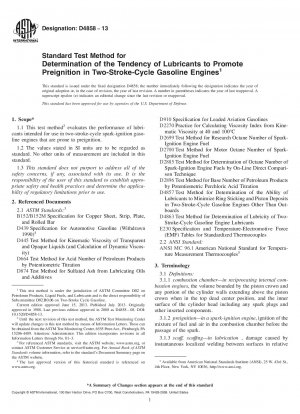ASTM D4858-13
Standard Test Method for Determination of the Tendency of Lubricants to Promote Preignition in Two-Stroke-Cycle Gasoline Engines
- Standard No.
- ASTM D4858-13
- Release Date
- 2013
- Published By
- American Society for Testing and Materials (ASTM)
- Latest
- ASTM D4858-13
- Scope
5.1 Two-stroke-cycle gasoline engines are generally more prone to preignition than are four-stroke-cycle engines due to the absence of the internal cooling that takes place during the induction stroke of the four-stroke-cycle engines. Preignition can lead to major piston damage, either directly due to localized overheating or as the result of preignition-induced detonation. Some lubricant additives that are widely used in four-stroke-cycle gasoline engine oils are known to increase the probability of preignition in gasoline two-stroke-cycle engines. This procedure is used to determine the tendency of an oil to induce preignition in both water-cooled and air-cooled two-stroke-cycle gasoline engines.
1.1 This test method2 evaluates the performance of lubricants intended for use in two-stroke-cycle spark-ignition gasoline engines that are prone to preignition.
ASTM D4858-13 Referenced Document
- ASTM B152/B152M Standard Specification for Copper Sheet, Strip, Plate, and Rolled Bar
- ASTM D2270 Standard Practice for Calculating Viscosity Index From Kinematic Viscosity at 40 and 100176C
- ASTM D2699 Standard Test Method for Research Octane Number of Spark-Ignition Engine Fuel
- ASTM D2700 Standard Test Method for Motor Octane Number of Spark-Ignition Engine Fuel
- ASTM D2885 Standard Test Method for Research and Motor Method Octane Ratings Using On-Line Analyzers
- ASTM D2896 Standard Test Method for Base Number of Petroleum Products by Potentiometric Perchloric Acid Titration
- ASTM D439 Standard Specification for Automotive Gasoline
- ASTM D445 Standard Test Method for Kinematic Viscosity of Transparent and Opaque Liquids (the Calculation of Dynamic Viscosity)
- ASTM D4857 Standard Test Method for Determination of the Ability of Lubricants to Minimize Ring Sticking and Piston Deposits in Two-Stroke-Cycle Gasoline Engines Other Than Outboards
- ASTM D4863 Standard Test Method for Determination of Lubricity of Two-Stroke-Cycle Gasoline Engine Lubricants
- ASTM D664 Standard Test Method for Acid Number of Petroleum Products by Potentiometric Titration
- ASTM D874 Standard Test Method for Sulfated Ash from Lubricating Oils and Additives
- ASTM D910 Standard Specification for Aviation Gasolines
- ASTM E230 Standard Specification and Temperature-Electromotive Force (EMF) Tables for Standardized Thermocouples
ASTM D4858-13 history
- 2013 ASTM D4858-13 Standard Test Method for Determination of the Tendency of Lubricants to Promote Preignition in Two-Stroke-Cycle Gasoline Engines
- 2008 ASTM D4858-08 Standard Test Method for Determination of the Tendency of Lubricants to Promote Preignition in Two-Stroke-Cycle Gasoline Engines
- 2002 ASTM D4858-02 Standard Test Method for Determination of the Tendency of Lubricants to Promote Preignition in Two-Stroke-Cycle Gasoline Engines
- 2000 ASTM D4858-00 Standard Test Method for Determination of the Tendency of Lubricants to Promote Preignition in Two-Stroke-Cycle Gasoline Engines
